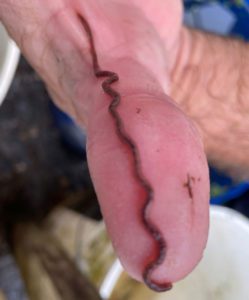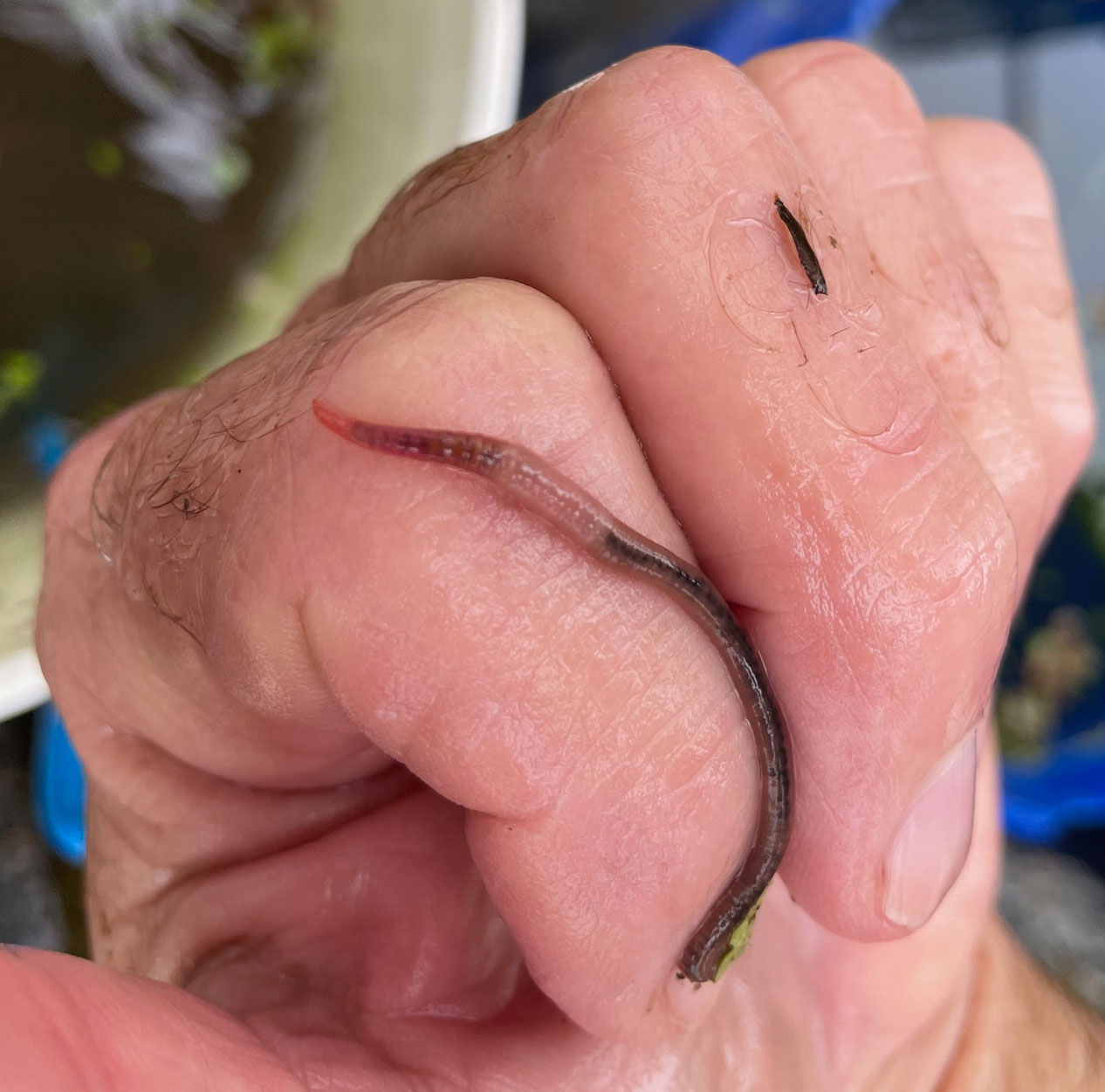Photo: A likely Diplocardia ornata, a vat worm found in one of our vats and crawling on author’s hand.
Long ago, I promised a blog updating two species of “vat worms” found in our greenhouses. At long last, I’ve just finished it. Before you read this blog, you might want to get some historical context by reading these blogs, which are listed in the order they were written:
https://goliadfarms.com/maybe-i-can-get-some-invertebrates-identified-finally/
https://goliadfarms.com/update-on-gammarus-identification/
https://goliadfarms.com/litter-worm-update/
At the end of the last blog above, I wrote, “By the way, Matt subsequently told me the vat worms are in fact TWO entirely different species. I’ll blog about them shortly.” Well…shortly has finally arrived.
Here’s what Matt emailed me about the two species of vat worms:
_________________________________________________________
Hi Charles,
Heard back from the Canadian worm expert. You have two species of “vat worm”, Diplocardia ornata and Eukerria saltensis. Diplocardia ornata is the larger, pale pink worm. The genus Diplocardia is endemic to central North America, from the Great Lakes region south to Texas. There are 40+ species, and a few live in boggy or semiaquatic conditions similar to the duckweed vat. Eukerria saltensis is the smaller, red worm. Eukerria saltensis is a semi-aquatic worm native to South America. It has been introduced throughout the tropics, and has been moving steadily into temperate areas as the climate warms. It is considered a rice paddy pest, where it can cause turbidity and algae blooms, as well as weakening dikes through its burrowing. Let me know if you have any questions, or any more invertebrates that need identifying!
Matthew A. Hill, Taxonomist
_________________________________________________________
So far, we haven’t tried to culture these two species; we simply let them do their thing in our systems. Both tend to hang around at the water line in our vats. There is often a ring of duckweed and algae providing shelter there. But we also find them at the bottoms of vats when we net out the vats to process fish, especially in livebearer vats. I suppose the cichlids are more likely to eat them. The photo at the beginning and the one following were taken this week as we processed some livebearers. The photo at the top is of what I think is Diplocardia ornata. The one below is, I believe, Eukerria saltensis. Both were netted up with livebearers we were working, but were from different vats.

Another worm that has become established in our system is a Tubifex. This worm survives our hot summer water temperatures without any problem. I do intend to attempt culturing it. I’m thinking of setting up shallow trays with coarse gravel and running system water through the trays. I suppose I should do some research on how others are culturing Tubifex. That research might be a good rainy winter day project.
Besides worms, a number of other species have colonized our greenhouses. This includes two species of livebearing snakes: Texas Garter Snake (Thamnophis sirtalis annectens) and Diamondback Water Snake (Nerodia rhombifer). For a short blog about the garter snake:
https://goliadfarms.com/texas-garter-snake/
In addition, there are at least two species of toads and two species of treefrogs living and reproducing in the greenhouses. I’ve seen juvenile Bull Frogs and adult Leopard Frogs in the greenhouses, but don’t think either is reproducing there. Two species of lizards have also established breeding populations in the greenhouses.
Some other invertebrates have also formed unintended breeding populations, including several spider species, lots of midges, biting flies (unfortunately), two aquatic snails, Fingernail Clams, and a freshwater sponge. See these blogs about the latter two:
https://goliadfarms.com/fingernail-clams-sphaerium-corneum/
https://goliadfarms.com/bryozoan-to-be-or-not-to-be/
I’ve discovered that in a large enough system your degree of control is much reduced. Some of these I don’t mind, but don’t get me started on duckweed:
https://goliadfarms.com/duckweed-and-chickens/
Thanks for reading. Good fishkeeping!


Maureen Jensen says
Hi… I’ve enjoyed reading through the blog about the scuds- I work on a fish farm in Ruskin FL… once before a few months back, one pond had them- and last week also. Funny , my boss wears wet suit boots and I have just some water sneaker type shoes. Well- the scuds love his boots, I think they are made of neoprene, and live the Velcro areas. I took a few home the first time and put in a 10 gallon, now brought a hundred or so this last week – Was wondering on how to care for them- that’s where your info is so appreciated! At the farm some small unused vats had a thick layer of algae and I have brought home from a time before to use in making “Snello”… Brought home a fist size clump of a sponge- can’t wait to read as you learn about those also!
To seine a pond is sometimes like opening a present- you just never know besides the cichlids what you’ll have.
This latest pond — he has a small concern as to the low count of under 1” … We threw out the thought : if there was a large number of gammarus – if the fry went in the grassy area where they were- could the tiny fry be overtaken by them?
Thanks again – Maureen in Tampa Bay
Charles Clapsaddle says
Maureen, I wouldn’t worry about the scuds eating the fry, but they will eat eggs. A problem we have in our scud cultures is the introduction of guppies. They are significant scud predators. Guppies get introduced accidentally when we take excess hornwort (scuds favorite food) from our 300-gallon cichlid breeding vats to feed the scud cultures. We have large numbers of feeder guppies in the cichlid breeder vats, and guppy fry hitchhike on the hornwort and rapidly grow and reproduce like mad in the scud vats.
Charles